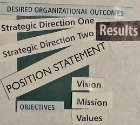Home Page | Blog | Managing | Marketing | Planning | Strategy | Sales | Service | Networking | Voice Marketing Inc.
Product Strategy:
Use One of Two Best Strategies
Then Use An Action Plan Template
to Build Your Plan
Building an effective product strategy is more than developing differentiation or diversification tactics. Use an example of a strategic marketing plan (include product, promotion, price and place) to define strategic planning of your product effectively.
Search This Site

Product strategy is a fairly intense and complex strategy development.
Most small business owners invest a lot of their resources upfront developing and/or finding their product or products.
Then, small business owners spend more resources on the new product launch and entering the market.
Often, after the product is launched, the product is expected to 'make it' on its own.
But product management needs to consider product life cycle, product differentiation (compared to competitive products), and strategies to build and grow product sales.
Define strategic planning in terms of your product strategy; all the rest (price, promotion and place) revolve around the product.

Use an action plan template to build your action items and goals.
You need to also develop your strategy for after you've launched your new product.
You need to build a strategy program that helps you grow your market share. There are a number of ways to do this: you can grow through market strategies, sales strategies, price strategies, promotion strategies, distribution strategies (known as 'place' in the 4 Ps of Marketing). and product strategies (and there are more growth strategies to uncover).
Two Best (or Favorite) Product Strategies:
Product Development
Product development needs to consider the buyer, the buyer needs and how the product's benefits meet those needs, the product's position (product positioning) in the market, and what unique advantage the product introduces into the market.
Once you've introduced your product, ensure that it continues to meet the market's needs and develop your product as necessary.
New product development requires focused planning, development and launch.
The risk with new product development is increased costs and failure to sell the new product or enhance product at higher sales values and at the planned volume (or higher).
Mitigate the risk by ensuring that your new product development approach is structured and requires approval and validation at each step of the process. Your approach for new product development needs to be focused and you need to follow your plan.
Product Diversification
Product diversification as a strategy can be costly in an operations environment and also in an inventory-based environment but it can be a highly successful and profitable product strategy.
Product diversification is about supporting your existing business and spreading the risk of one product or one line by diversifying with more related, or even unrelated, products that help to grow your small business sales and spread risk (for example, flatten seasonality).
From an example of strategic marketing plan: some businesses have adopted a "one stop shop" model and have added products that existing customers buy from others in the supply chain. The important key to successful diversification is making good choices.
The risk with product diversification is that you might 'thin' your sales rather than increase sales overall.
Mitigate that risk by choosing your product diversification targets wisely; choose to diversify with products that have limited competition, that add depth and/or breadth to your existing product or products, or that have significant buyer demand.
Building the right product strategies are key to your business. You need to define strategic planning activities and use your action plan template for an effective strategic marketing plan.
More-For-Small-Business Newsletter:
For more timely and regular monthly information on managing your
small business,
please subscribe here.
Read more the relationship of analyses to strategy in your business:
Return to Strategy.
Or return from Product Strategy to More For Small Business Home Page.
Review the criteria required to build a Value Chain Analysis for your business.
Subscribe to
More Business Resources E-zine
The Importance of Strategy
Why is strategizing important to your business?
Because it enables you to more clearly understand what you need to do to more your operation in the direction you need, and want, to go.
Doing a thorough analysis and review will enable you to implement more effective strategies, tactics and techniques.
Results and Strategy

Definition of Business Model: It's Different
The type of tactical planning you complete as you strategize is important because it forces you to make difficult choices and difficult decisions.
(Make sure you understand the definition business model - the practices, and focus, of the business on delivering the value proposition - to engage in a strong and successful strategic planning process).
Also write down your choices and decisions to plan the actions necessary to move forward (use samples to provide you with a model for your own action plan).
The action plan is your road map. You must ensure that you are managing the direction you take.
Once you begin this planning process you will need to ensure that the plan you develop is do-able; make sure you include effectiveness measures in your plan.
And remember that your plan for strategy in business needs to be reviewed on a regular basis and be adapted as market and economic conditions change.
The end goal is not the plan but rather the results therefore make sure you have measurements in place to track results.
This Site
Tools for Strategy Planning
Start with your SWOT (strengths, weaknesses, opportunities and threats) analysis.
Add aspirations and results to the SWOT (some do SOAR (strengths, opportunities, aspirations, and results) as a separate activity) to ensure that your vision for your business is incorporated in your goals and objectives.
Conduct a market opportunity analysis and look for unmet needs that align with your objectives.
Doing a thorough analysis and review will enable you to implement more effective strategies, tactics and techniques.







